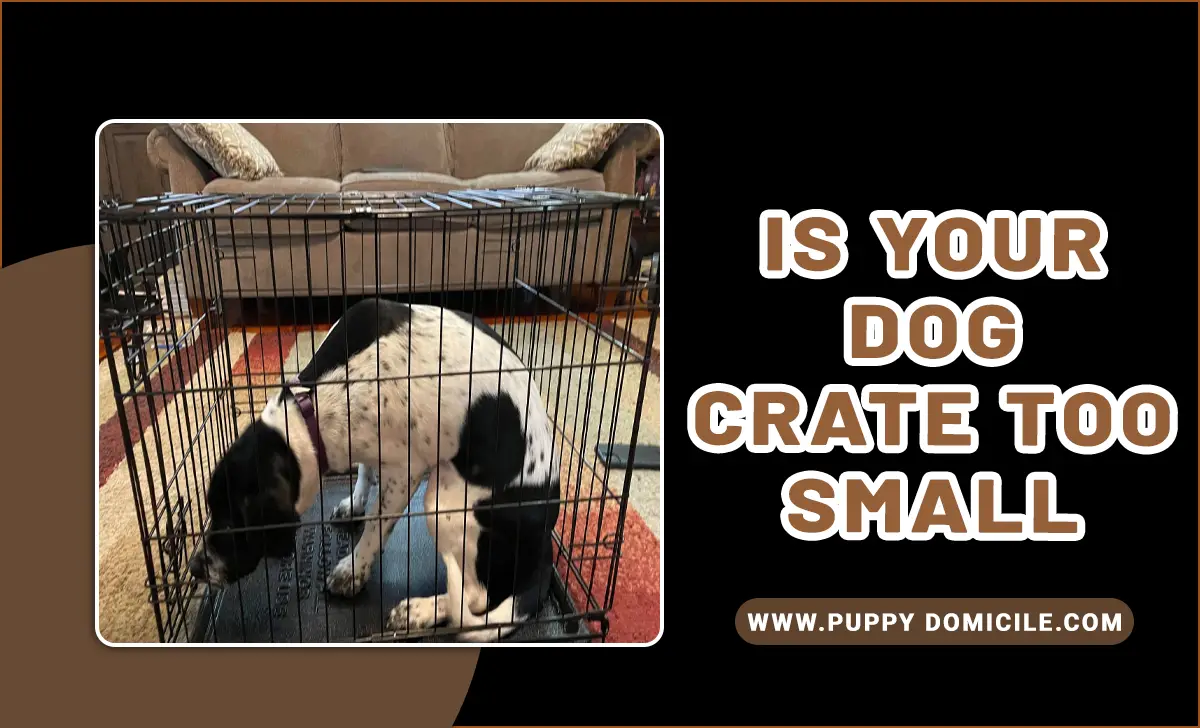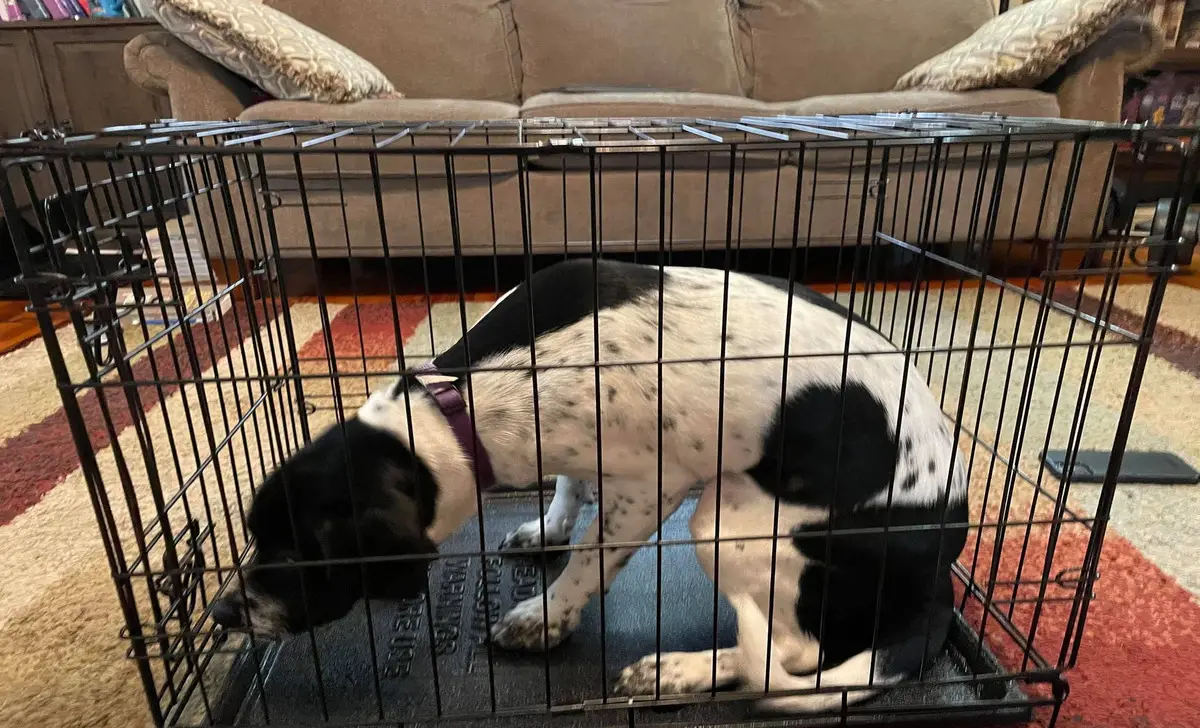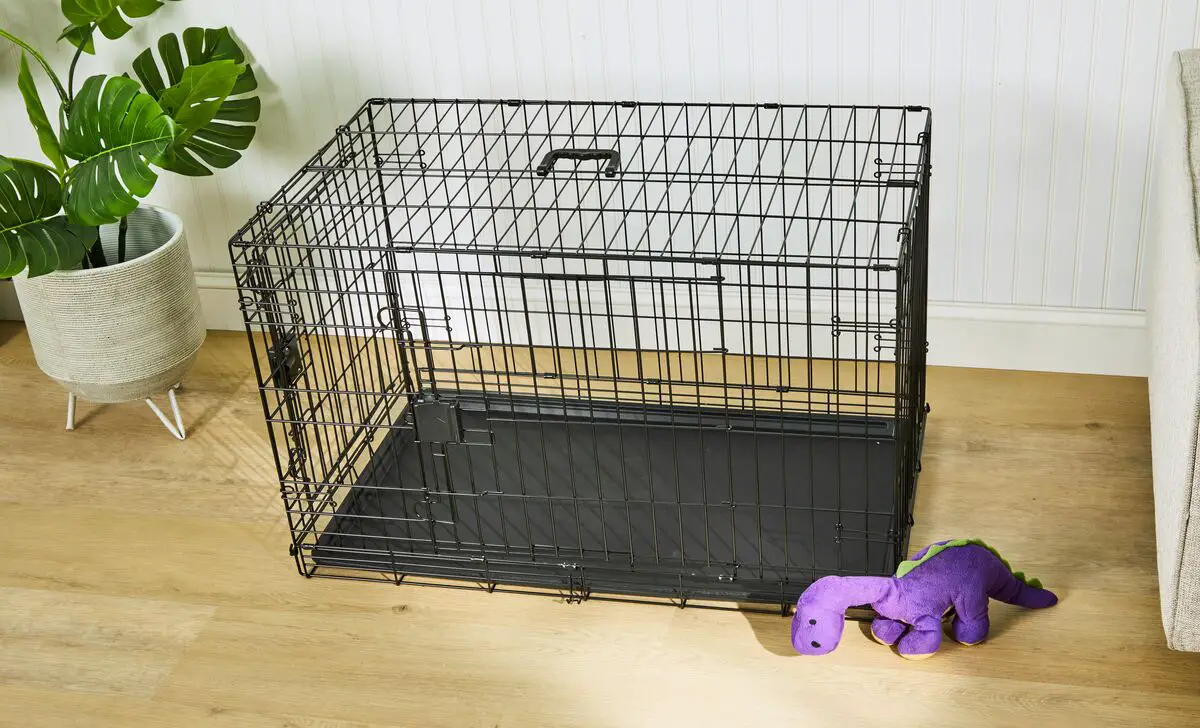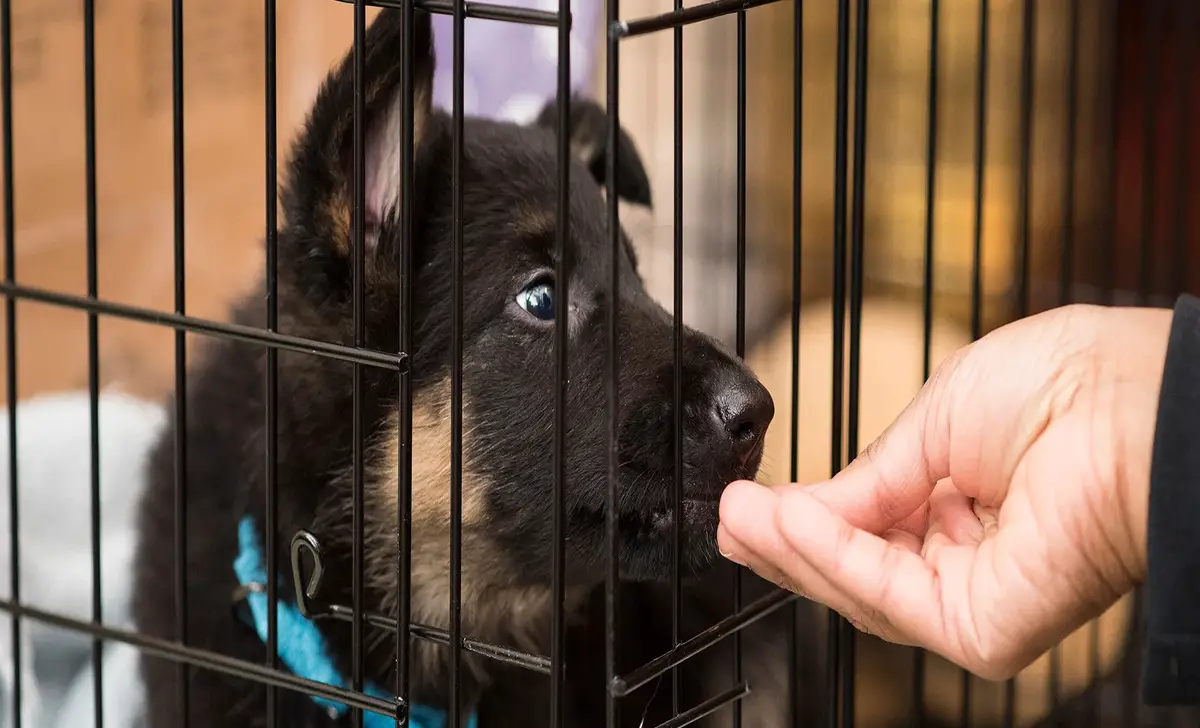As responsible pet owners, we all want to ensure the comfort and well-being of our beloved furry friends. A dog crate is a common tool for training and containment purposes.
While crates can be a useful tool when used properly. It is essential to make sure that the crate is the appropriate size for your dog. A crate that is too small can cause unnecessary stress and discomfort for your pet, leading to potential behavioural issues and health problems.
In this article, we will discuss the signs that indicate your dog crate may be too small. The negative effects of confining your dog in a too-small crate, and how to properly measure and choose the right size crate for your canine companion. So, let’s start.

Dangers Of Keeping Your Dog In A Small Crate
Keeping your dog in a too small crate can pose various dangers to their physical and mental well-being. Dogs need space to stand, turn around, and stretch comfortably in their crates to prevent muscle stiffness and discomfort.
A crate that is too small may increase stress, anxiety, and even behavioural issues in your furry companion. Additionally, cramped conditions can restrict airflow and ventilation, potentially causing overheating or respiratory problems. It is crucial to ensure that your dog’s crate size is appropriate for their breed and size to provide a safe and comfortable environment for them when crated.
Is Your Dog Crate Too Small? Signs

Dogs love their space; a comfortable crate can be a great place to rest and relax. However, if the crate is too small. It can quickly become a source of discomfort and frustration for your furry friend. Signs that your dog crate is too small include difficulty standing up or turning around and exhibiting destructive behaviour.
1.Limited Movement
One of the signs that your dog crate may be too small is if your pet has limited movement inside it. Dogs should be able to stand up comfortably, turn around, and lie down with ease in their crate. If your dog seems cramped or unable to move freely within the crate, it may be a sign that a larger size
2.Crouching Or Bending

A clear sign that your dog crate may be too small is if your dog cannot stand up fully, crouch comfortably, or bend their body within the crate. Dogs naturally need space to adjust their position and move around comfortably, so if your dog appears cramped or restricted in their movements while inside the crate, it’s a strong indication that the crate is not providing adequate space for your pet.
3.Restlessness And Anxiety
If your dog is exhibiting signs of restlessness and anxiety, it could be a sign that their crate is too small. Dogs need space to move around comfortably, stretch out, and change positions while in their crates. When a dog feels cramped and restricted in their crate, they may become restless, anxious, or even agitated.
This can lead to behavior issues such as excessive barking, whining, or attempting to escape from the crate. To ensure your dog’s well-being and comfort, providing them with a crate that allows ample room to move and relax is essential.
4.Behavioural Signs

Behavioural signs can indicate that your dog’s crate is too small for them. If your dog shows signs of restlessness, excessive barking, or aggressive behavior when being placed in the crate, it may be a sign that they are feeling cramped and uncomfortable.
What Can You Do
Measuring your dog for a crate is important to ensure their comfort, safety, and well-being. A properly sized crate provides enough space for your dog to stand, turn around, and lie down comfortably, reducing anxiety and preventing injuries. It also aids in effective house training and behavior management by creating a secure, den-like environment that promotes a sense of security and routine.
If you suspect that your dog’s crate may be too small, there are a few steps you can take to address the issue professionally.
1.Measure Your Dog
Measure from the tip of your dog’s nose to the base of their tail. Add 2-4 inches to this measurement. Measure from the floor to the top of your dog’s head when standing. Add 2-4 inches to this measurement. Ensure the crate is wide enough for your dog to turn around comfortably.
Measure Height:
- Have your dog stand up straight.
- Measure from the floor to the top of their head.
- Add 2-4 inches to this measurement for comfort.
- Formula: Dog’s Height + 2-4 inches = Crate Height
Length:
- Measure from the tip of your dog’s nose to the base of their tail.
- Add 4-6 inches to this measurement for comfort.
- Formula: Dog’s Length + 4-6 inches = Crate Length
Measure Width:
- Typically, the width is proportional to the height and length.
- A common guideline is that the width should be about 2/3 of the crate length.
- Formula: Crate Length x 2/3 = Crate Width
2.Example Calculation
Dog’s Measurements: Height: 20 inches & Length: 30 inches
Crate Size:
- Height: 20 inches + 3 inches = 23 inches
- Length: 30 inches + 5 inches = 35 inches
- Width: 35 inches x 2/3 ≈ 23 inches
3.Choose The Right Crate Size
Use the measurements to select a crate that is appropriately sized for your dog. Consider purchasing an adjustable crate that can grow with your dog, especially if you have a puppy.
4.Consider The Crate Type
Provide good ventilation and visibility. Ideal for dogs who like to see their surroundings. Offer a more enclosed space, which can be comforting for dogs who like a den-like environment. Suitable for travel and lighter use but not recommended for chewers or escape artists.
5.Introduce The New Crate Gradually
Allow your dog to explore the new crate on their own. Place their favourite toys and treats inside. Start with short crate sessions and gradually increase the time as your dog becomes more comfortable.
6.Monitor Your Dog’s Comfort
Regularly check your dog’s fit in the crate and adjust as needed, especially as they grow or their needs change. Pay attention to any signs of discomfort, restlessness, or anxiety, and make necessary adjustments.
Conclusion
Keeping your dog in a small crate can lead to physical and psychological dangers. As pet owners, it is important to understand the right crate size for your dog and the signs that indicate that their current crate is too small.
Measuring your dog for a crate and considering age , breed, and weight will help you choose the right size. Ensuring that your dog’s crate is the right size is important. Some signs to look out for that may indicate that your dog crate is too small include difficulty standing up or turning around, excessive chewing or scratching at the crate, and reluctance to enter the crate.
By paying attention to these signs and ensuring that your dog has enough space in their crate, you can ensure its comfort and well-being.
Frequently Asked Questions
1.Can Your Dog Be Taken Out Of The Crate To Sit On The Sofa With Me?
No, it is not recommended to take your dog out of the crate to sit on the sofa with you. It is important to follow the guidance of professional dog trainers and provide a safe space for your dog in their crate.
2.How Much Room Should Your Dog Have In Your Crate?
The ideal crate size for your dog should allow them to stand up, turn around, and lie down comfortably. It should be spacious enough to provide a safe space for your dog without being too large. Consult professional dog trainers for guidance on crate training and crate sizes suitable for your dog’s breed and size.
3.How Can You Determine The Right Size Crate For Your Dog?
To determine the ideal crate size for your dog, consider the breed, age, and size of your dog. Measure your dog from the tip of the nose to the base of the tail, and from the top of the head to the ground when your dog is sitting.
Ensure that the crate is large enough for your dog to stand up, turn around, and lie down comfortably. Consult professional dog trainers or resources from the Humane Society for guidance on crate training and selecting the appropriate crate size for your dog.
4.Should Your Dog Be Able To Stand Up In Your Crate?
Yes, your dog should be able to stand up in the crate comfortably. Make sure to choose the ideal crate size based on your dog’s breed and size to provide a safe space for your furry friend. Consider consulting professional dog trainers for guidance on crate training your dog, especially if you have an older dog or a puppy.
The Humane Society recommends crate training as a valuable tool for dog training and a comfortable den for your pet. Remember to provide dog toys and crate covers to make the crate a welcoming environment for your dog, regardless of their breed or age.
5.Why Does Your Dog Choose To Go Into The Very Small Kennel Instead Of Your Bigger Kennel?
A dog may choose a small kennel over a bigger one due to factors such as feeling more secure in a confined space, being more comfortable in a cozy environment, or simply preferring the size and layout of the smaller crate. It is important to ensure that the crate size is suitable for the dog’s breed and size to provide a safe and comfortable space for them. Professional dog trainers can guide crate training and selecting the ideal crate size for your dog’s needs.
6.How Do You Choose The Best Crate For Medium Dogs?
When choosing the best crate for a medium dog, consider the size of the dog breed, the ideal crate size, and the materials of the crate. Consulting professional dog trainers and researching crate training methods can also help in making the right choice. Additionally, ensure the crate provides a safe space for your dog and consider factors like dog health and age when selecting a crate.
7.Should I Get A Larger Crate As My Dog Grows?
Yes, you should get a larger crate as your dog grows. A properly sized crate should be large enough for your dog to stand up, turn around, and lie comfortably.
8.What To Consider Before Buying A Dog Crate?
Before buying a dog crate, it is important to consider factors such as the ideal crate size for your dog, the type of crate (wire, plastic, etc.), and whether crate training is suitable for your dog’s breed and temperament.
Additionally, consulting professional dog trainers for advice on crate training methods and ensuring that the crate provides a safe and comfortable space for your dog are important considerations. Other factors to think about include the dog’s age, size, and specific needs, as well as any related articles or resources that may help in crate training.
